We offer top of the line surveillance and security solutions, so you can always stay informed about what’s happening around your business property.
Go Safer Security provides top-notch security services in Maryland, including comprehensive exit and Emergency Lighting services. Our team of experienced professionals are dedicated to keeping you and your business safe.
Exit signs are required to show people either the direct path to or the exact location of the exit door.
Emergency lighting is required to illuminate the path to the exit door.
What is the Difference Between Emergency and Fire Exit Lights?
Emergency and exit lights are a mandate in every building that has high occupancy, whether commercial or residential. However, not many understand the difference between emergency exit lights and fire exit lights. Both these exit lights are installed to direct occupants within a building to the quickest escape route possible. With both being used in tandem, it is easy to get confused between the two.Here’s how you can distinguish between the two:
There are instances where buildings experience power outages. In these situations, every commercial or residential building, hotel, apartment, or These lights are battery-operated and follow certain compliance codes that are mandatory for all emergency lights. Every emergency light is required to have the right placement and be functioning at all times to ensure safe removal of people from the buildings during emergencies such as a fire.
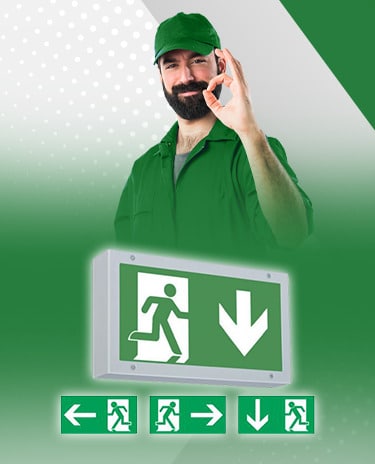

Fire exit lights are lit-up exit signs for fire escapes or emergency exits that guide people toward the direction of the last escape route. While fire exits are usually referred to as emergency exits, they exist for the sole purpose of being the escape when usual exit routes are not possible. Unlike the usual exits that open somewhere within the buildings, fire exits open towards the outdoors at a point of safety for the occupants of the building. These exits are required to be easily accessible and must be kept free of any possible blockages.
Emergency lighting systems help occupants navigate and safely exit the building in a fire or security-related emergency. Emergency lights, exit signs, and panic doors are safety devices that are just as important as fire alarm systems. (Check here to learn more about how the fire alarm system works.) While the latter communicates a crisis, emergency pathway lights and exits work together to ensure building occupants evacuate safely. If you want to learn how to integrate your emergency lighting to your existing home security system, check out our guide to home automation here.
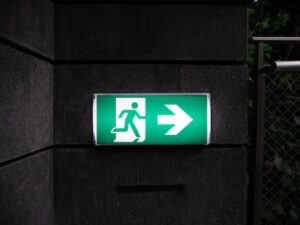
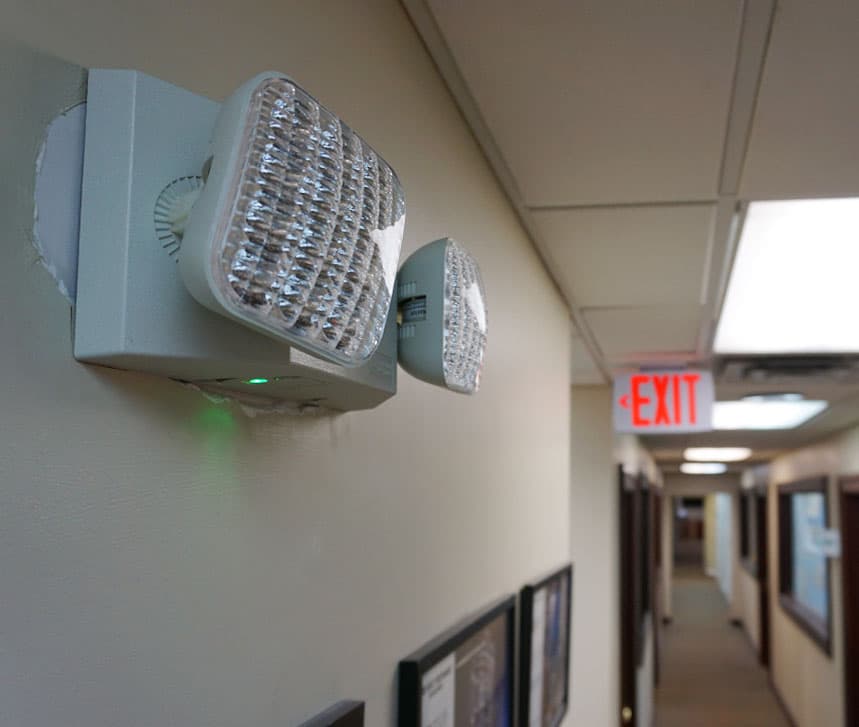
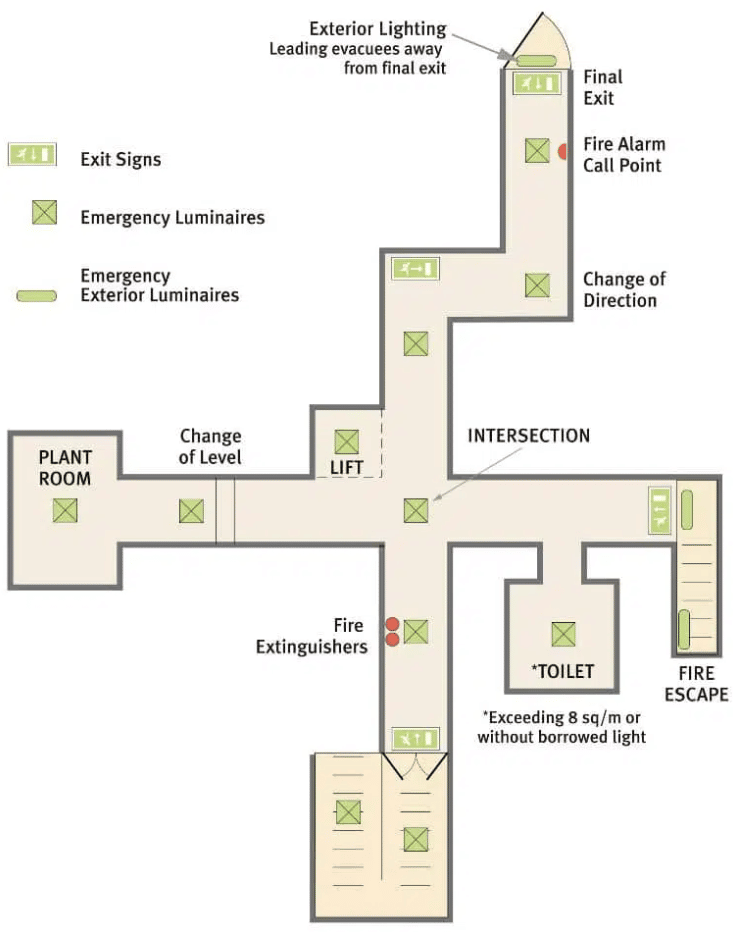
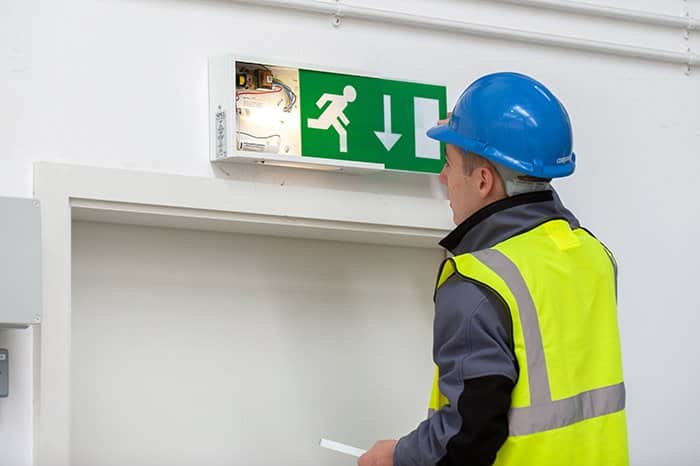
Emergency exit lighting is a type of lighting system designed to provide illumination in the event of an emergency situation. It is typically installed in buildings and other areas where people may need to evacuate quickly. The purpose of this lighting is to clearly mark the exits and provide enough light for occupants to safely navigate their way out of the building.
Emergency exit lighting systems are typically powered by a backup power source, such as a generator or battery, so they will remain operational even during a power outage. This type of lighting is usually accompanied by signs that indicate the direction of the exit, as well as any other safety information that may be pertinent during an evacuation.
Emergency exit lighting plays an important role in helping people evacuate safely during an emergency situation. It can help reduce panic and confusion, which can lead to injuries or worse if not addressed properly. For this reason, it’s important that all buildings have adequate emergency exit lighting systems in place at all times.
Yes, emergency exit lights must be on a dedicated circuit. This is because they are required to remain lit even if the main power supply has been disrupted. If they were connected to a regular circuit, then they would not be able to provide any light in an emergency situation.
It’s important that emergency exit lighting is reliable and always functioning properly. This is why it needs to be installed on a dedicated circuit that has its own power source. In addition, this circuit should be tested regularly to ensure that the lights will work when needed.
Finally, it’s important to note that local building codes may require special wiring for emergency exit lights. It’s best to consult with an electrician or other qualified professional when installing these lights in order to ensure that all applicable regulations are met.
Emergency lighting should be serviced regularly to ensure it is in proper working order and ready to use in the event of an emergency. The frequency of servicing depends on the type of system and its environment. For example, emergency lighting systems installed in areas with high levels of dust or moisture may need more frequent servicing than those located in a clean and dry environment.
In general, it is recommended that emergency lighting systems are tested every month and serviced at least once a year. During the service, all components should be checked for functionality and any faulty parts should be replaced. Additionally, batteries should be tested to make sure they are fully charged and able to provide the required amount of light when needed.
It is important to note that regular maintenance and testing can help prevent malfunctions during an emergency situation. Therefore, it is essential to follow the manufacturer’s recommendation for servicing your system as well as any relevant local regulations or codes.
Fire exits and emergency exits are both designed to provide a safe way to evacuate a building in the event of an emergency. The primary difference between the two types of exits is the purpose for which they are intended. Fire exits are specifically designed to provide a safe escape route in the event of a fire, while emergency exits may be used for any type of emergency evacuation, including fires, natural disasters, or other dangerous situations.
Fire exits are typically marked with signs indicating their purpose and must meet specific requirements regarding size and construction materials. They should also be located near stairwells and other areas that can provide easy access in the event of an evacuation. Emergency exits may not have to meet as strict requirements, but they should still be clearly marked and easily accessible.
Both fire exits and emergency exits are important safety features in any building and should be maintained regularly to ensure that they remain functional during an emergency situation.
When servicing a lighting system, it’s important to take safety precautions. First, make sure to turn off the power before beginning any work. This will prevent electric shock or other accidents. It’s also important to wear protective gear such as gloves, goggles and a face mask when handling hazardous materials like cleaning chemicals or wiring. Additionally, be sure to use the correct tools for the job and follow all manufacturer instructions carefully. Finally, if you feel uncomfortable with any task, it’s best to stop and consult a professional electrician for help. Following these simple safety rules can help ensure that your lighting system is serviced safely and correctly.
Exit and emergency lighting is an essential safety feature in commercial and public buildings. The main components of these systems include: LED lights, battery backup power supplies, control devices, and mounting hardware. LED lights are preferred over traditional fluorescent bulbs because they are more energy-efficient and have a longer lifespan. Battery backup power supplies are critical so that the lights can continue to function during a power outage. Control devices include circuit breakers and timers that allow for programming and maintenance.
Mounting hardware includes brackets and fixtures that secure the lights to the wall or ceiling. By ensuring that all of these components are functioning properly, building owners can provide a safe and reliable means of exit in emergency situations. If you have any issues with your exit and emergency lighting system, it is important to seek assistance from a professional technician to address the problem promptly. For tips on how to address common components problems, visit our blog post here.
Yes, a fire panel is required for exit emergency lighting in commercial buildings. The fire panel plays a critical role in monitoring the emergency lighting system and helps ensure that it functions as intended during emergencies.
Regular fire panel inspections offer several benefits for commercial building owners, such as better identifying potential issues, reducing false alarms and malfunctions, and ensuring compliance with industry standards. These inspections can help detect and address issues with wiring, battery backup, and other components of the emergency lighting system before they become significant problems.
By ensuring that your fire panel and emergency lighting system are regularly inspected and maintained, you can help protect your building against harm to property, harm to occupants, and potential legal liabilities. So, it is highly recommended to hire a professional inspection service to carry out regular inspections and maintenance of your fire panel and emergency lighting system.
Call 1-800-GO-SAFER (467-2337) and speak with our GSS Specialist or complete the form and we will contact you.
What type of business do you have? This will help us determine the specific needs of your business and recommend cameras that are best suited for your industry.